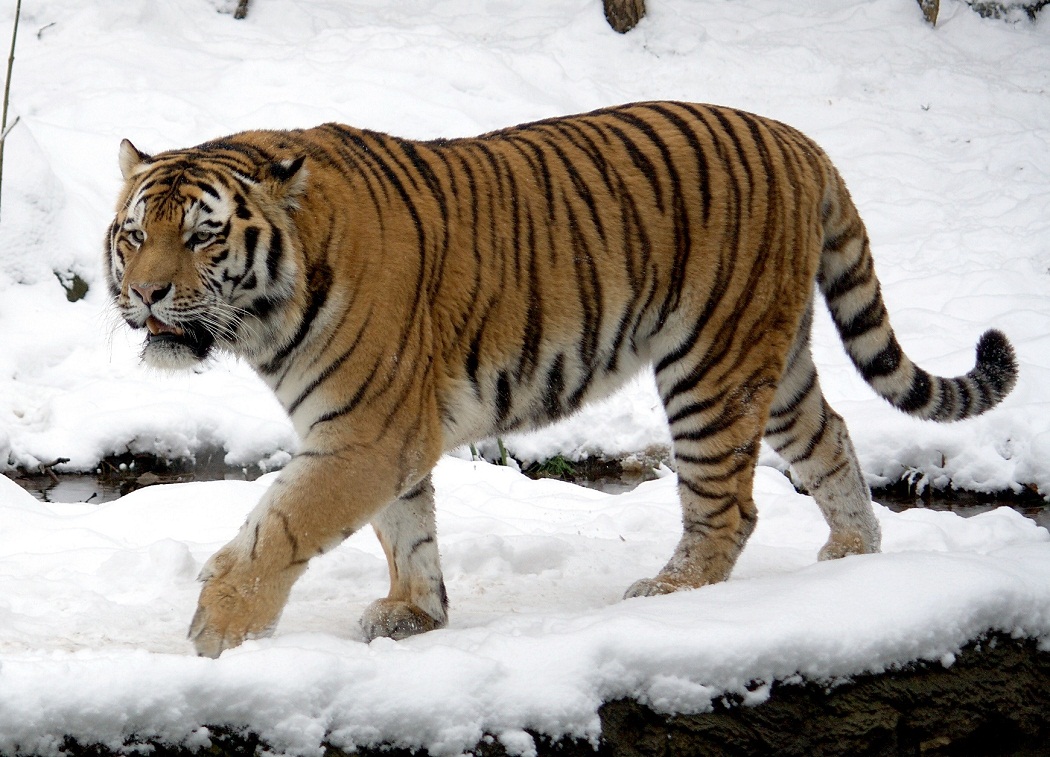Tigers have evolved specialized physical and behavioral adaptations that allow them to expertly hunt prey and thrive in their environment.
The tiger’s striped coat helps it blend into its surroundings while stalking prey.
This article explores how these majestic big cats are uniquely equipped for survival.
How Do Tigers Adapt to Their Environment?
Tigers have evolved a range of specialized physical and behavioral adaptations that allow them to expertly hunt prey and thrive across diverse habitats in Asia.
Key Points:
- Tigers rely on camouflage and night vision to stealthily ambush prey. Their stripes and tapetum lucidum aid hunting.
- Powerful jaws, sharp teeth, and large padded paws make tigers effective killers able to take down large prey.
- Highly adaptable to varied habitats like forests, swamps, and snow. Subspecies adapted to unique environments.
Tigers Rely on Camouflage to Ambush Prey
A tiger’s stripes and coat coloration provides camouflage by breaking up the animal’s shape and blending it into its surroundings.
This benefits tigers when they are hunting prey during the day, allowing them to remain hidden from potential prey until they are within striking distance.
Their orange coat with black stripes resembles blades of grass or shadows helping tigers stay concealed when approaching prey.
The tiger’s camouflage pattern makes it extremely difficult for prey animals to detect them in dense vegetation.
This stealth ability gives tigers an important advantage during hunts in their environment.
How Do Tigers Hunt Effectively at Night?
In addition to relying on camouflage, tigers have excellent night vision due to a reflective layer in their eyes called the tapetum lucidum.
This adaptation allows tigers to see up to six times better in the dark compared to humans.
Their specialized night vision enables tigers to hunt effectively at night when many prey animals have a harder time detecting predators.
Hunting at night also helps tigers avoid competition from other predators like leopards that don’t see as well in the dark.
Overall, the tiger’s superior night hunting capabilities are a key evolutionary adaptation for surviving in its natural environment.
Powerful Jaws and Teeth Make Tigers Effective Killers
A tiger’s powerful jaws and teeth make them effective hunters able to take down prey even larger than themselves.
Using their incredible bite force, tigers can crush the vertebrae of prey at the back of the neck.
Their long canine teeth are used for grabbing and piercing prey.
The carnassials, which are specialized teeth at the back of a tiger’s mouth, act like scissors to shear meat off bones.
Tiger teeth are replaced throughout their lifetime helping keep their bites deadly.
These evolutionary adaptations equip tigers with the tools they need to kill prey quickly and effectively.
Large Padded Paws Enable Silent Stalking
One of the tiger’s remarkable adaptations is their large paws with soft pads that enable them to silently sneak up on prey without making a sound.
Their paw pads also have small bumps called papillae that give them traction and help tigers grip the ground when running or capturing prey.
Tigers have five toes on their front paws and four on their hind paws, with sharp retractable claws aiding in hunting.
The tiger’s paw size helps support its, large body size.
Overall, the tiger’s big, padded paws are an important evolutionary adaptation aiding their ambush hunting strategy by allowing them to stealthily approach prey without making a sound.
Tigers Thrive in a Variety of Habitats
Tigers are highly adaptable and able to thrive in a variety of habitats including tropical rainforests, evergreen forests, temperate forests, mangrove swamps, and grasslands.
Different subspecies are adapted to their unique environments.
For example, Siberian tigers have thicker fur coats and can hunt effectively even in deep snow.
Bengal tigers frequent areas of dense vegetation where prey is abundant.
Regardless of habitat, all tigers rely on access to water sources and cover for hunting prey.
Their remarkable adaptability has enabled tigers to become apex predators across multiple habitat types in Asia.
Tigers Modify Hunting Habits to Avoid Competition
Tigers will shift their hunting activity patterns to avoid competition with other predators in their environment.
For example, when leopards are present in their habitat, tigers will tend to hunt at different times of day or night to minimize competition over shared prey resources.
Where brown bears are common, tigers may avoid confronting them over fresh kills due to the risks of injury.
This ability to modify habits in response to other predators is an important adaptation allowing tigers to coexist and reduce conflict.
Their flexibility and intelligence help them adapt to changing conditions.
Bengal Tigers Frequent Dense Vegetation to Find Prey
The Bengal tiger’s preference for dense vegetation provides the cover they require for ambush hunting their preferred prey like deer, wild boar, and monkeys.
Areas with heavy undergrowth, reeds, and tall grasses provide excellent camouflage for tigers to conceal themselves from potential prey.
Bengal tigers frequent these types of areas where their prey animals are abundant.
They will also hunt near watering holes where prey animals gather.
Their skill at stealthily approaching prey through dense vegetation makes Bengal tigers effective hunters in the environments they inhabit.
Siberian Tigers Have Adaptations for Cold Weather
Siberian tigers, also known as Amur tigers, live in the harsh, cold climate of eastern Russia.
Evolutionary adaptations enable them to thrive in this challenging environment.
Siberian tigers have thicker coats than other tiger subspecies to provide insulation in frigid conditions.
Their pale coats also provide camouflage in snowy winter conditions.
Siberian tigers hunt prey like elk, wild boar, and even brown bears.
Shorter, stockier builds minimize surface area to retain body heat.
Small ears reduce heat loss.
Siberian tigers are excellent swimmers, and helpful for fishing.
These adaptations enable Siberian tigers to dominate their frozen landscape.
Tigers Mark Territory to Communicate with Other Tigers
Tigers frequently spray urine mixed with secretions from scent glands onto trees, rocks, or the ground to mark their territories.
These chemical messages communicate information on the tiger’s identity, gender, and reproductive status to other tigers.
Marking territory is an important adaptation that helps minimize violent confrontations between tigers over shared ranges and resources.
It enables them to maintain stable home ranges that support essential needs like hunting without excessive conflict.
This form of chemical communication is vital to tiger survival and adaptation in social environments.
Why Is Overhunting a Threat to Biodiversity?
Overhunting poses a severe threat to biodiversity and ecological stability.
When top predators like tigers are overhunted, it causes cascading effects down the food chain.
Prey species can overpopulate and destroy their habitat.
Removal of keystone species throws ecosystems out of balance.
Local extinctions occur, impacting biodiversity.
Genetic diversity declines when population numbers crash.
Overhunting shrinks gene pools and species ranges, increasing extinction risk.
Poaching driven by the illegal wildlife trade has decimated tiger populations across Asia.
Only about 3,900 wild tigers remain.
Trophy hunting and traditional Chinese medicine have also fueled declines.
Banning poaching and trade in tiger parts is crucial.
Preserving habitat corridors between isolated populations can help sustain genetic diversity.
If tigers and other apex predators are lost, entire ecosystems would be irreversibly damaged.
Strict protections are vital to prevent the overhunting of endangered tigers.
In Summary
Tigers have evolved remarkable physical and behavioral adaptations enabling them to expertly hunt prey and thrive in a variety of environments across Asia.
Their camouflage, night vision, powerful jaws, stealthy paws, and flexibility make tigers highly skilled predators able to dominate their habitats.
These evolutionary advantages provide the tiger with the attributes required to survive and adapt over generations.
FAQ:
What Is a Tapetum Lucidum?
A tapetum lucidum is a reflective layer behind the retina in a tiger’s eyes that causes eyeshine and improves night vision. It allows tigers to see up to six times better in low light compared to humans.
How Fast Can a Tiger Run?
Tigers can reach top speeds of about 35-40 miles per hour over short distances. Their large, muscular hind legs provide power while running. Their paw pads give them traction when sprinting.
What Do Tigers Eat?
Tigers are carnivores that typically hunt large prey like deer, wild pigs, cattle, and buffalo. Tigers may also eat smaller animals like rabbits, fish, birds, or even reptiles when available.
At GreenChiCafe, we are passionate about the environment and our natural world. Be sure to check out our website for more content about fascinating animals like the incredible tiger!

Annie is a passionate environmental writer and activist. She has been writing about sustainability, conservation, and green living for over 15+ years. Annie is dedicated to raising awareness about environmental issues and providing practical tips for living an eco-friendly lifestyle. When she’s not writing, you can find her volunteering with local environmental organizations, teaching workshops on zero waste living, or exploring nature. Feel free to get in touch with Annie: annie@greenchicafe.com


